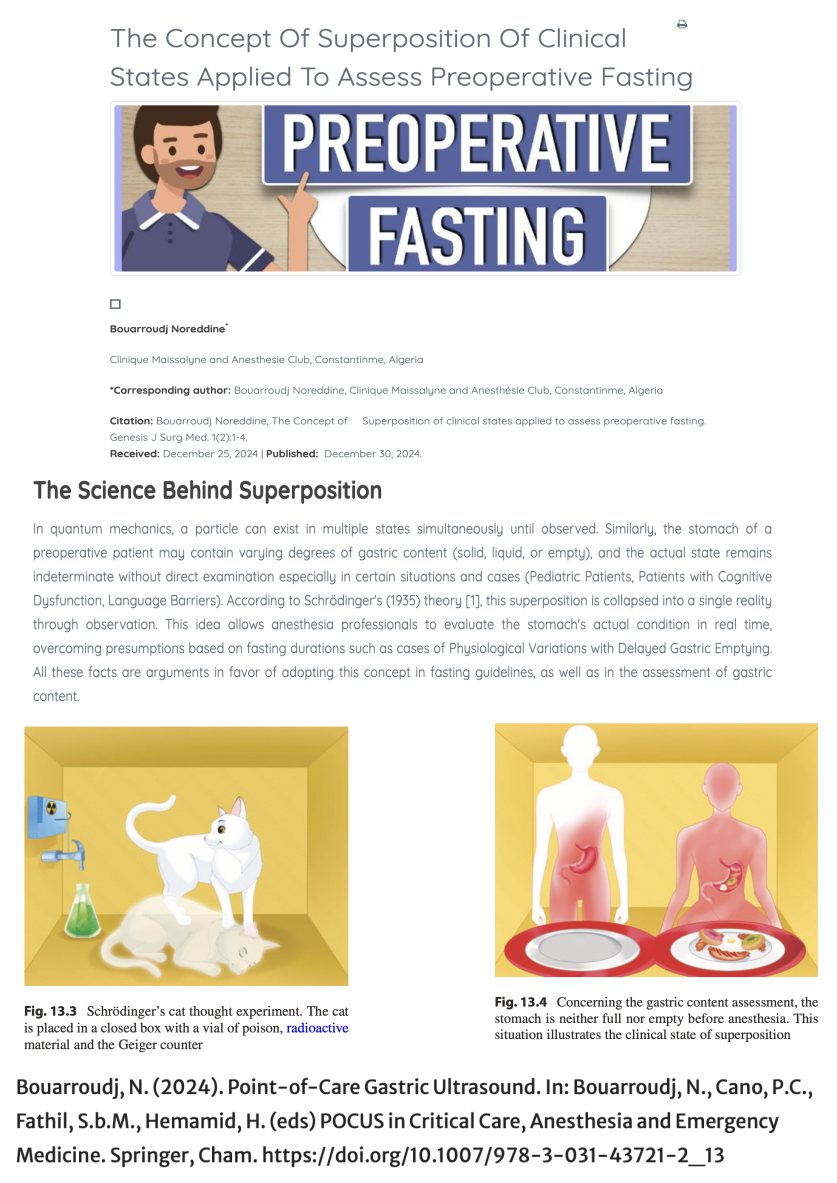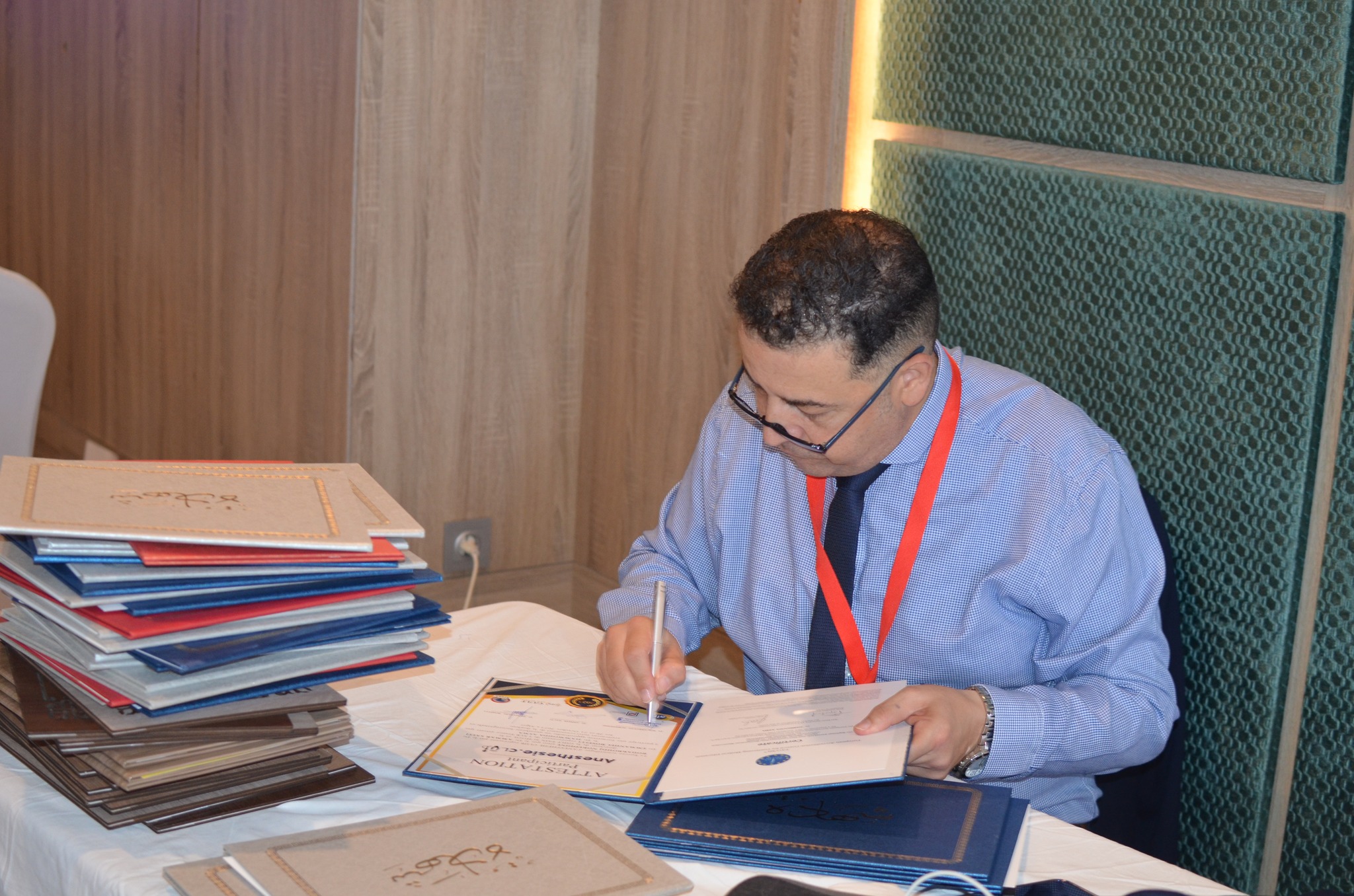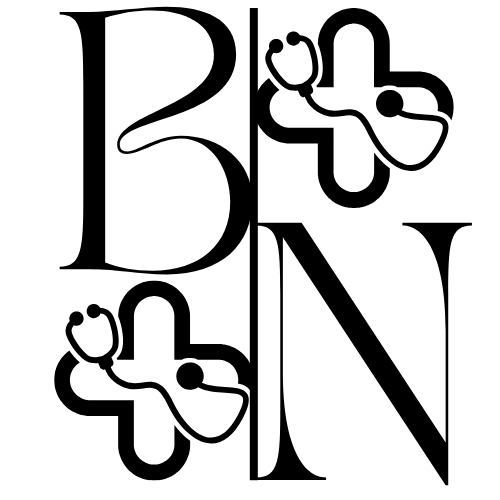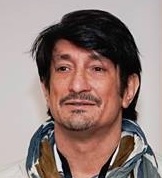The Concept of Superposition of Clinical States Applied to Assess Preoperative Fasting
Bouarroudj Noreddine*
Clinique Maissalyne and Anesthesie Club, Constantine, Algeria
*Corresponding author: Bouarroudj Noreddine, Clinique Maissalyne and Anesthésie Club, Constantinme, Algeria
Citation: Bouarroudj Noreddine, The Concept of Superposition of clinical states applied to assess preoperative fasting. Genesis J Surg Med. 1(2):1-4.
Received: December 25, 2024 | Published: December 30, 2024.
Copyright©️ 2024 genesis pub by Noreddine B. CC BY-NC-ND 4.0 DEED. This is an open-access article distributed under the terms of the Creative Commons Attribution-Non Commercial-No Derivatives 4.0 International License. This allows others distribute, remix, tweak, and build upon the work, even commercially, as long as they credit the authors for the original creation.

Introduction
To minimize the risk of pulmonary aspiration, preoperative fasting is a fundamental component and a cornerstone of safe anesthesia practice. However, the strict time-based fasting protocols that are frequently used in current guidelines fail to adequately account for the inherent uncertainties and unknowns that may exist in unclear situations of gastric emptying (uncertainties in patient histories, comorbidities, and physiological states). In this conceptual editorial we suggest an emerging term and concept of superposition of clinical states inspired by quantum mechanics. By analogy to Schrödinger’s quantum thought, where a cat is simultaneously alive and dead until observed, we propose in unclear situations that the stomach before anesthesia exists in a state of superposition where the stomach is both full and empty at the same time. Binary thinking, which aims to determine whether a patient is fasting or not, can only be subjective in certain cases because it does not consider unknowns and uncertainties. Therefore, it is reasonable to expect that only direct observation, such as through gastric ultrasound, resolves this uncertainty.
The Concept of Superposition of clinical states should improve how the anesthesia and critical care community assess preoperative gastric content. Also, this concept challenges the binary thinking in fasting protocols and highlights the need for point-of-care gastric ultrasound as a critical tool to individualize patient care.
Let’s investigate this paradigm and promote its implementation in contemporary anesthesia.
The Science Behind Superposition
In quantum mechanics, a particle can exist in multiple states simultaneously until observed. Similarly, the stomach of a preoperative patient may contain varying degrees of gastric content (solid, liquid, or empty), and the actual state remains indeterminate without direct examination especially in certain situations and cases (Pediatric Patients, Patients with Cognitive Dysfunction, Language Barriers). According to Schrödinger’s (1935) theory [1], this superposition is collapsed into a single reality through observation. This idea allows anesthesia professionals to evaluate the stomach’s actual condition in real time, overcoming presumptions based on fasting durations such as cases of Physiological Variations with Delayed Gastric Emptying. All these facts are arguments in favor of adopting this concept in fasting guidelines, as well as in the assessment of gastric content.
Data and Endorsements Supporting This Concept
There is no doubt that there are limitations in standard fasting guidelines, emphasizing the need for individualized approaches. Indeed, as highlighted by Hector Perera and col [2], a notable discrepancy was observed between the existing fasting practices and the guidelines established by the American Society of Anesthesiologists, the European Society of Anesthesiology, the Association of Anesthetists of Great Britain and Ireland, and the Royal College of Nursing. Also, according to P. Van de Putte and col [3] more research is needed to establish the clinical implications of these findings in the elective setting. The authors conclude that the clinical function of gastric ultrasonography is still to evaluate the contents of the stomach to direct treatment in cases where the risk of aspiration is unknown or unclear. This is how our concept of superposition of clinical states can be useful. Similarly, Charlesworth and Wiles (2019) introduced the metaphor of Schrödinger’s gut (should we look inside Schrödinger’s gut?) [4], highlighting the indeterminate state of gastric contents before intervention. This concept was discussed and proposed in our publication on Point-of-Care Gastric Ultrasound chapter [5] which outlines its ability to assess gastric content and volume accurately.
Practical Applications: Gastric Superposition States
Superposition states often arise in:
- Unclear or Uncertain Situations :
- Pediatric Patients: Miscommunication regarding fasting times.
- Patients with Cognitive Dysfunction: Difficulty in providing reliable fasting histories.
- Language Barriers: Misunderstandings about fasting instructions.
2. Physiological Variations with Delayed Gastric Emptying:
- Chronic gastric atony in diabetes or scleroderma.
- Active labor or pregnancy.
- Severe liver or kidney dysfunction.
3. Post-Surgical or Pathological Alterations:
- History of vagotomy, gastric resection, or alkaline reflux gastritis.
- Neuromuscular disorders affecting gastric motility.
- Obesity or critical illness.
In all these scenarios, Point-of-Care Gastric Ultrasound offers a solution to confirm or refute gastric emptiness, thus collapsing the superposition state and guiding safe clinical decisions.
Solutions to the Problem
- Integration of Gastric Ultrasound: Equip anesthesiology departments with ultrasound devices and train providers in their use.
- Revision of Fasting Guidelines: Collaborate with societies like ASA to incorporate contextualized assessments using Point-of-Care Gastric Ultrasound into fasting protocols. As Dourish pointed out, we must know “what we are talking about when we talk about preoperative fasting” [6].
- Education and Awareness: Promote the concept of gastric superposition states through conferences, workshops, and academic curricula.
Conclusion
As Charlesworth and Wiles aptly stated, “It’s time to look inside Schrödinger’s gut.” The concept of superposition of clinical states provides a convincing framework for reevaluating fasting prior to surgery. By recognizing the indeterminate nature of gastric contents and employing Point-of-Care Gastric Ultrasound to resolve this uncertainty, we can enhance patient safety and tailor anesthesia practices to individual needs.
Let us adopt this innovative perspective and spearhead a perioperative care paradigm change. We invite readers to ponder: Are we prepared to break down the superposition state and use Point-of-Care Gastric Ultrasound to reveal the real nature of preoperative fasting?
Similar to the quantum world, observation holds the key to the solution especially since the principle of superposition extends beyond anesthesia.
References
- Schrödinger E. (1935) Die gegenwärtige Situation in der Quantenmechanik. Naturwissenschaften. 23: 807–812.
- Perera H, Wusu A, Mohammad A, Qulaghassi MZ and Abdulkarim A. (2023) An Audit on the Pre-operative Fasting Time of Trauma-List Orthopaedic Patients at a District General Hospital in Chichester, United Kingdom. Cureus. 15(11): e48327.
- Van de Putte P, Vernieuwe L, Jerjir A, Verschueren L, and Tacken M et al. (2017). When fasted is not empty: a retrospective cohort study of gastric content in fasted surgical patients†. Br J Anaesth. 118(3);363–371.
- Charlesworth M, and Wiles MD. (2019). Pre-operative gastric ultrasound – should we look inside Schrödinger’s gut? Anaesthesia. 74(1):109-112.
- Bouarroudj, N. (2024). Point-of-Care Gastric Ultrasound. In: Bouarroudj, N., Cano, P.C., Fathil, S.b.M., Hemamid, H. (eds) POCUS in Critical Care, Anesthesia and Emergency Medicine. Springer, Cham
- Dourish P. (2004) What we talk about when we talk about context. Pers Ubiquit Comput 8:19-30.












